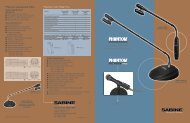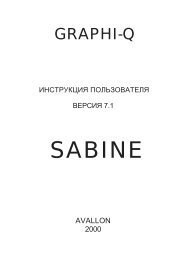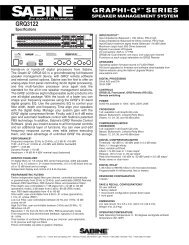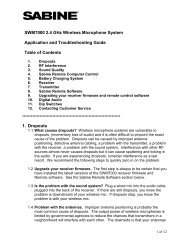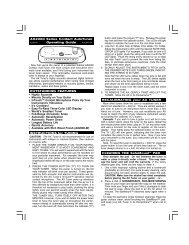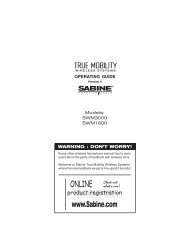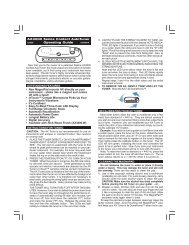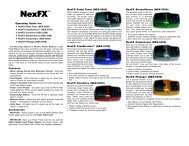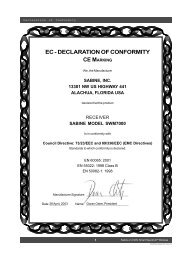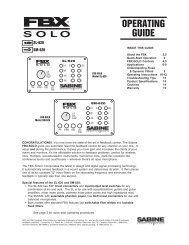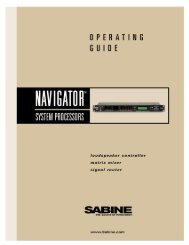op guide - Sabine, Inc.
op guide - Sabine, Inc.
op guide - Sabine, Inc.
You also want an ePaper? Increase the reach of your titles
YUMPU automatically turns print PDFs into web optimized ePapers that Google loves.
SECTION seven — FBX Theory & Practice7.1. Introduction to FBX®WHY FBX? Feedback is certainly the most pervasive challenge to the audio industry. Thepotential appearance of sudden, loud, out-of-control feedback is every sound engineer’sand musician’s nightmare. Unlike more subtle audio quality problems or shortcomings,feedback is embarrassingly obvious — it disturbs the performer, the audience, and thetechnician, and can damage equipment and just generally ruin your day.Feedback is a potential problem in any amplified sound system that places a micr<strong>op</strong>honeor pickup in proximity to a loudspeaker. Poor acoustical conditions or mis<strong>guide</strong>d use byuns<strong>op</strong>histicated sound system <strong>op</strong>erators only aggravate the situation. To make matters stillworse, a non-<strong>Sabine</strong> variety of wireless micr<strong>op</strong>hone adds yet another level of feedbackdanger to the picture. Since feedback erupts whenever the distance, location, and gainrelationships between a speaker and a micr<strong>op</strong>hone reach a critical combination, a micthat can move anywhere results in an ever changing potential for feedback. A step in thewrong direction may change a clear sound to a piercing shriek in less than a second.This enhanced potential for feedback with a wireless system gets worse if lavalier micr<strong>op</strong>honesare used. Such micr<strong>op</strong>hones are usually placed farther from the mouth thanhandheld or head set micr<strong>op</strong>hones, thus requiring more gain. Also, the polar patternof a lavalier micr<strong>op</strong>hone is frequently omnidirectional. Thus, the likelihood of feedbackincreases, due to the micr<strong>op</strong>hone’s increased off-axis sensitivity to the sound emanatingfrom the loudspeakers.The <strong>Sabine</strong> FBX2810 systems solve feedback problems by precise attenuation of verynarrow bands of feedback-prone frequencies. The process is automatic, simple to use,adaptable to changing acoustical conditions and relationships, powerful in its application,and has minimal consequences to the audio fidelity of the signal. We call this automaticfilter an FBX Feedback Exterminator® filter, or FBX filter for short.7.2. The Advantages of FBX FiltersBefore the invention of FBX, the most common device for controlling feedback was the31-band graphic EQ. However, an FBX filter offers three distinct advantages over graphicfilters.1. First and most obvious is the automatic nature of FBX filters. When feedback occurs,FBX responds more quickly than even the most experienced engineer. AutomaticFBX placement works even in the presence of audio program material, intelligentlydistinguishing feedback from music or speech.2. A second advantage is that FBX micro-filters are precisely placed anywhere feedbackoccurs (with 1 Hz resolution), while graphic EQ filters are limited to 31 fixed centerpoints. An FBX filter represents a direct hit on feedback! In contrast, a graphic EQfilter can only approximate the exact frequency of the feedback, and the filter (or filters)with the closest center frequency must be pulled down. Such filters are deepest attheir centers, and such imprecise attenuation takes a big (and unnecessary) chunkout of your sound (see figure 7a).3. <strong>Inc</strong>reased clarity and gain-before-feedback are further accomplished by the third andmost important advantage of FBX: <strong>Sabine</strong>’s micro-filters are ten times narrower than31-band EQ filters. Using FBX micro-filters will return up to 90 percent of the powerremoved by EQ filters.Here’s a good place to make a very important distinction. Graphic EQ filters are typicallycalled “1/3-octave,” but it’s important to understand that this term refers to the spacing ofthe filter centers (1/3-octave apart), and not the width of the filter (usually a full octave).Graphic filters thus overlap one another, and affect frequencies well above and belowthe center point frequency, including frequencies of adjacent bands. This makes graphicequalizers very practical tools for shaping sound “with broad strokes,” such as dialing inoverall system EQ, but results in destructive audio quality overkill when they are usedto eliminate feedback. A graphic equalizer would need more than 10,000 narrow-bandsliders to be as precise and powerful as your FBX.As an example of the power of FBX, figure 7b shows test results measured with a PA setup consisting of a micr<strong>op</strong>hone, mixer, FBX Feedback Exterminator®, power amp and twospeakers. The system’s gain was first raised until the FBX removed nine feedback points.Next, the FBX was replaced with a graphic EQ. The EQ was adjusted while the systemgain was raised to the same level achieved with the FBX. The frequency response curvesof each device were then plotted and are compared in figure 7b. Note how much moreof the program (the “good audio”) is eliminated using an EQ — whereas only feedbackis eliminated using FBX filters.-10 dB cut at 500, 630, 1K, 1.25K, 1.6K & 2K HzIf the graphic EQ really had 1/3 octavefilter widths, the frequency response curvewould vary 6 dB between sliders. Thiswould ruin the sound.Fig. 7a.Graphic EQs usually use one-octavewideoverlapping filters that provide muchsmoother frequency response curves.Notice that the overlapping filters addtogether to cut -16 dB when the slidersare only pulled down -10 dB.8





